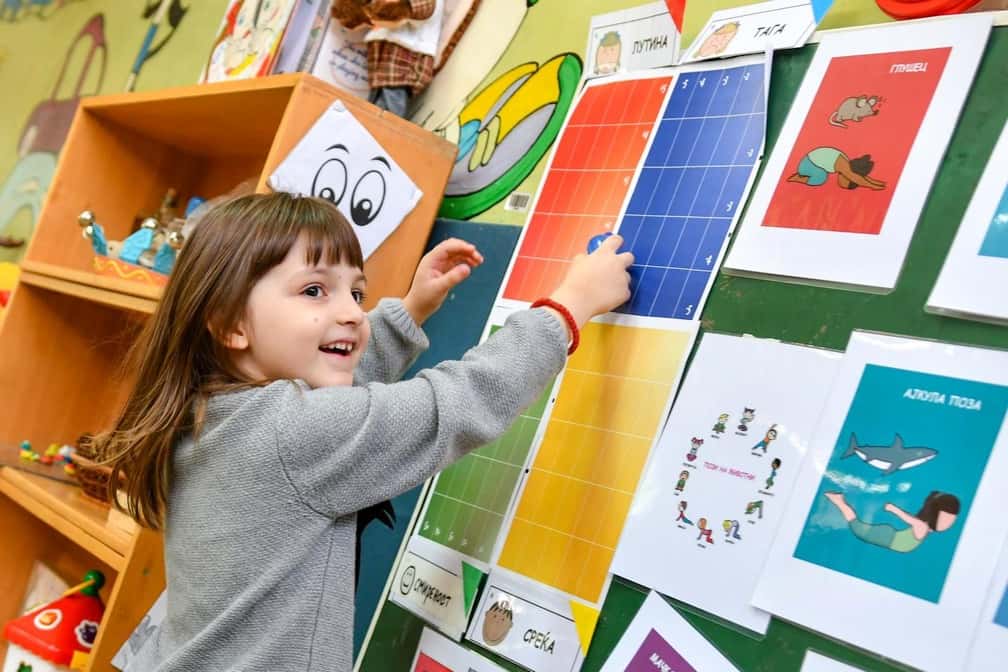Here are 120 fun educational and learning activities for children ages 4 to 6. These give you some great ideas to capture the attention and focus children on things that will help them develop their thinking and physical skills.
- Play with puzzles: puzzles are a great way to help children develop problem-solving and spatial reasoning skills.
- Play with blocks: children can build and create with blocks, which helps them develop fine motor skills and creativity.
- Have a scavenger hunt: create a list of items for children to find around the house or neighborhood, which helps them build observation and critical thinking skills.
- Do a science experiment: try a simple experiment like making a volcano with baking soda and vinegar, which helps children learn about cause and effect.
- Play with playdough: children can use playdough to build and create, which helps them develop fine motor skills and creativity.
- Do a craft: try a simple craft like making a paper mache bowl, which helps children develop fine motor skills and creativity.
- Read a book: reading helps children build vocabulary and comprehension skills.
- Have a picnic: take a blanket outside and have a picnic, which helps children learn about different foods and how to eat in a social setting.
- Play a board game: board games like Chutes and Ladders or Candyland can help children learn about taking turns, following rules, and counting.
- Play a card game: children can play a simple card game like “Go Fish” to practice numbers and matching.
- Practice fine motor skills: children can use small objects like pompoms or pipe cleaners to practice grasping and manipulating small items, which helps them develop fine motor skills.
- Practice letter recognition: children can use refrigerator magnets or index cards to practice identifying and matching letters.
- Practice spelling: children can use letter tiles or cut-out letters to practice spelling simple words.
- Practice sorting: children can use small objects like buttons or beads to practice sorting by size, shape, or color.
- Practice handwriting: children can use a workbook or simple sheets of paper to practice writing letters and numbers.
- Practice cutting skills: children can use child-safe scissors and simple craft materials like construction paper to practice cutting in a straight line or following a pattern.
- Do a simple art project: children can create a picture or craft using materials like paint, crayons, or glue, which helps them develop creativity and fine motor skills.
- Practice storytelling: children can use household items like stuffed animals or dolls to create a story and act it out, which helps them develop creativity and communication skills.
- Practice following directions: children can use household objects to play simple games that involve following verbal or written instructions.
- Practice rhyming: children can use a rhyming workbook or simple sheets of paper to practice identifying and creating rhyming words.
- Do a simple math activity: children can use small objects like counters or chips to practice basic math skills like counting, addition and subtraction.
- Practice counting money: children can use play money and a toy cash register to practice counting and making simple monetary transactions.
- Practice measuring: children can use simple household items like spoons and cups to practice measuring and basic math skills.
- Practice telling time: children can use a toy clock or a simple worksheet to practice reading and telling time.
- Practice matching upper and lowercase letters: children can use letter tiles or cut-out letters to practice matching upper and lowercase letters.
- Practice phonics: children can use a phonics workbook or simple sheets of paper to practice identifying and sounding out different letters and letter combinations.
- Practice matching upper and lowercase letters: children can use letter tiles or cut-out letters to practice matching upper and lowercase letters.
- Practice spatial awareness: children can use simple household objects to practice visualizing and manipulating 3D objects.
- Practice word recognition: children can use simple flashcards or a word recognition workbook to practice identifying and reading different words.
- Practice basic hygiene skills: children can use a toy doctor set or simple materials like washcloths and soap to practice basic hygiene skills like handwashing.
- Practice basic carpentry skills: children can use simple tools and materials like popsicle sticks or plasticine to build and create, which helps them develop fine motor skills and creativity.
- Practice basic sewing skills: children can use a child-safe needle and thread or a simple sewing kit to practice basic sewing skills like tying knots and following a seam.
- Practice basic drawing skills: children can use a simple drawing workbook or blank paper to practice basic drawing skills like shading and perspective.
- Practice basic sign language: children can use a simple sign language workbook or app to practice basic sign language and learn about communication.
- Practice basic origami skills: children can use simple origami instructions and materials like paper to practice basic origami skills like folding and creasing.
- Go on a nature walk: take a walk outside and have children identify different plants and animals, which helps them learn about the natural world.
- Play a musical instrument: even simple instruments like a kazoo or drum can help children learn about music and rhythm.
- Have a storytelling session: take turns telling stories, which helps children build their imagination and communication skills.
- Play dress up: children can use costumes and props to act out different roles and scenarios, which helps them develop creativity and social skills.
- Do a yoga or exercise session: try a simple yoga routine or do some basic exercises like jumping jacks or push-ups, which helps children develop physical coordination and self-regulation.
- Play with water: children can use cups, bowls, and other containers to play with water, which helps them learn about volume and measurement.
- Have a painting session: give children paper and paint (or even just a bowl of water and a paintbrush) and let them create their own masterpieces, which helps them develop creativity and fine motor skills.
- Play a memory game: try a simple memory game like “Concentration,” where children have to remember where different items are placed, which helps them develop memory and concentration skills.
- Do a gardening project: children can help plant seeds or tend to a small garden, which helps them learn about the natural world and responsibility.
- Play with play kitchen toys: children can use play kitchen toys to pretend to cook and serve food, which helps them learn about nutrition and social skills.
- Do a dance party: put on some music and have a dance party, which helps children develop coordination and self-expression.
- Play with puppets: children can use puppets to act out stories and create their own shows, which helps them develop creativity and communication skills.
- Play with clay: children can use clay to sculpt and create, which helps them develop fine motor skills and creativity.
- Do a cooking project: children can help measure and mix ingredients to make a simple recipe, which helps them learn about cooking and nutrition.
- Play with a parachute: children can use a parachute to play games and create movements, which helps them develop coordination and teamwork skills.
- Play with a hopscotch board: children can hop on different squares and practice their balance, which helps them develop coordination and gross motor skills.
- Do a color matching activity: children can sort different objects by color or match different colored objects, which helps them learn about colors and categorization.
- Play with stickers: children can use stickers to create scenes or decorate objects, which helps them develop fine motor skills and creativity.
- Play with a ball: children can play simple ball games like catch or kickball, which helps them develop coordination and teamwork skills.
- Do a sensory bin activity: fill a bin with materials like rice, beans, or pasta and let children explore and create, which helps them develop sensory awareness and creativity.
- Have a tea party: children can pretend to serve tea and snacks to each other, which helps them learn about social skills and manners.
- Play with a water table: children can use a water table to play with water, sand, and other materials, which helps them learn about cause and effect and sensory exploration.
- Play with toy cars: children can use toy cars to race or create their own scenes, which helps them develop creativity and fine motor skills.
- Play with a hula hoop: children can use a hula hoop for games and exercises, which helps them develop coordination and gross motor skills.
- Do a sticker mosaic: children can use stickers to create a picture or design, which helps them develop fine motor skills and creativity.
- Play with a foam puzzle: children can use foam puzzle pieces to build and create, which helps them develop fine motor skills and spatial reasoning.
- Play with a foam alphabet mat: children can use the mat to spell out words or create their own designs, which helps them learn about letters and spelling.
- Do a color sorting activity: children can sort different objects by color or create a color wheel, which helps them learn about colors and categorization.
- Play with a foam dress-up set: children can use the foam pieces to create their own outfits, which helps them develop creativity and fine motor skills.
- Do a shadow matching activity: children can use objects to create shadows and match the shadows to the objects, which helps them learn about light and shadow.
- Do a treasure hunt: create a list of items for children to find around the house or neighborhood, which helps them build observation and critical thinking skills.
- Play with a foam farm set: children can use the foam pieces to create their own farm scenes and act out stories, which helps them develop creativity and social skills.
- Play with a foam zoo set: children can use the foam pieces to create their own zoo scenes and act out stories, which helps them develop creativity and social skills.
- Do a matching game: children can match different objects or pictures, which helps them develop memory and concentration skills.
- Play with a foam dinosaur set: children can use the foam pieces to create their own dinosaur scenes and act out stories, which helps them develop creativity and social skills.
- Play with a foam castle set: children can use the foam pieces to create their own castle scenes and act out stories, which helps them develop creativity and social skills.
- Play with a foam transportation set: children can use the foam pieces to create their own transportation scenes and act out stories, which helps them develop creativity and social skills.
- Do a puzzle matching game: children can match different puzzle pieces to create a picture, which helps them develop problem-solving and fine motor skills.
- Play with a foam animal set: children can use the foam pieces to create their own animal scenes and act out stories, which helps them develop creativity and social skills.
- Do a shape matching game: children can match different shapes or create pictures using different shapes, which helps them learn about shapes and spatial reasoning.
- Do a shadow puppet show: children can use their hands or simple puppets to create shadow figures on a wall, which helps them develop creativity and fine motor skills.
- Play with a foam dress-up set: children can use the foam pieces to create their own outfits and act out stories, which helps them develop creativity and social skills.
- Do a simple magic trick: children can learn a simple magic trick like making a coin disappear, which helps them develop problem-solving and fine motor skills.
- Play with a foam sports set: children can use the foam pieces to create their own sports scenes and act out stories, which helps them develop creativity and social skills.
- Play with a foam space set: children can use the foam pieces to create their own space scenes and act out stories, which helps them develop creativity and social skills.
- Play with a foam pirate set: children can use the foam pieces to create their own pirate scenes and act out stories, which helps them develop creativity and social skills.
- Play with a foam safari set: children can use the foam pieces to create their own safari scenes and act out stories, which helps them develop creativity and social skills.
- Do a simple science experiment: children can try a simple experiment like making a lemon volcano or observing how plants grow, which helps them learn about cause and effect and the natural world.
- Play with a foam superhero set: children can use the foam pieces to create their own superhero scenes and act out stories, which helps them develop creativity and social skills.
- Do a simple art project: children can create a picture or craft using materials like paint, crayons, or glue, which helps them develop creativity and fine motor skills.
- Play with a toy dollhouse: children can use a toy dollhouse to create their own scenes and act out stories, which helps them develop creativity and social skills.
- Play with a toy airport set: children can use a toy airport set to create their own scenes and act out stories, which helps them develop creativity and social skills.
- Play with a toy garage set: children can use a toy garage set to create their own scenes and act out stories, which helps them develop creativity and social skills.
- Play with a toy grocery store set: children can use a toy grocery store set to create their own scenes and act out stories, which helps them develop creativity and social skills.
- Play with a toy restaurant set: children can use a toy restaurant set to create their own scenes and act out stories, which helps them develop creativity and social skills.
- Play with a toy construction set: children can use a toy construction set to build and create, which helps them develop fine motor skills and creativity.
- Play with a toy farm set: children can use a toy farm set to create their own scenes and act out stories, which helps them develop creativity and social skills.
- Play with a toy doctor set: children can use a toy doctor set to create their own scenes and act out stories, which helps them develop creativity and social skills.
- Play with a toy castle set: children can use a toy castle set to create their own scenes and act out stories, which helps them develop creativity and social skills.
- Play with a toy train set: children can use a toy train set to create their own tracks and act out stories, which helps them develop creativity and social skills.
- Play with a toy dinosaur set: children can use a toy dinosaur set to create their own scenes and act out stories, which helps them develop creativity and social skills.
- Play with a toy car set: children can use a toy car set to create their own tracks and races, which helps them develop creativity and fine motor skills.
- Play with a toy spaceship set: children can use a toy spaceship set to create their own scenes and act out stories, which helps them develop creativity and social skills.
- Play with a toy robot set: children can use a toy robot set to create their own scenes and act out stories, which helps them develop creativity and social skills.
- Play with a toy pirate set: children can use a toy pirate set to create their own scenes and act out stories, which helps them develop creativity and social skills.
- Play with a toy superhero set: children can use a toy superhero set to create their own scenes and act out stories, which helps them develop creativity and social skills.
- Play with a toy dinosaur excavation set: children can use a toy dinosaur excavation set to dig for and identify different dinosaur bones, which helps them learn about paleontology and fine motor skills.
- Play with a toy animal habitat set: children can use a toy animal habitat set to create their own scenes and learn about different animals and their habitats, which helps them develop creativity and knowledge about the natural world.
- Play with a toy musical instrument set: children can use a toy musical instrument set to make music and learn about rhythm and sound, which helps them develop creativity and musical skills.
- Play with a toy kitchen set: children can use a toy kitchen set to pretend to cook and serve food, which helps them learn about nutrition and social skills.
- Play with a toy tool set: children can use a toy tool set to build and create, which helps them develop fine motor skills and creativity.
- Play with a toy sports equipment set: children can use a toy sports equipment set to practice different sports and learn about teamwork, which helps them develop physical coordination and social skills.
- Play with a toy art set: children can use a toy art set to create their own pictures and crafts, which helps them develop creativity and fine motor skills.
- Play with a toy dress-up set: children can use a toy dress-up set to create their own outfits and act out stories, which helps them develop creativity and social skills.
- Play with a toy beach set: children can use a toy beach set to create their own scenes and act out stories, which helps them develop creativity and social skills.
- Play with a toy puppet theater: children can use a toy puppet theater to create their own shows and act out stories, which helps them develop creativity and communication skills.
- Play with a toy puzzle set: children can use a toy puzzle set to build and create, which helps them develop fine motor skills and problem-solving skills.
- Play with a toy memory game: children can use a toy memory game to practice remembering and matching different objects, which helps them develop memory and concentration skills.
- Play with a toy building block set: children can use a toy building block set to build and create, which helps them develop fine motor skills and creativity.
- Play with a toy shape sorter: children can use a toy shape sorter to practice identifying and matching different shapes, which helps them learn about shapes and fine motor skills.
- Play with a toy memory matching game: children can use a toy memory matching game to practice remembering and matching different objects, which helps them develop memory and concentration skills.
- Play with a toy matching game: children can use a toy matching game to practice matching different objects or pictures, which helps them develop memory and concentration skills.
- Play with a toy stacking toy: children can use a toy stacking toy to practice stacking and creating different structures, which helps them develop fine motor skills and creativity.
- Play with a toy peg board: children can use a toy peg board to practice fitting different shaped pegs into the board, which helps them develop fine motor skills and problem-solving skills.
- Play with a toy lacing toy: children can use a toy lacing toy to practice lacing and tying different shapes or patterns, which helps them develop fine motor skills and hand-eye coordination.
-love learning -your best ed lessons guide, Scott




